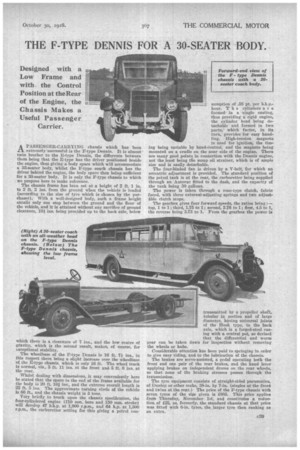THE F-TYPE DENNIS FOR A 30-SEATER BODY.
Page 47

If you've noticed an error in this article please click here to report it so we can fix it.
A PASSENGER-CARRYING chassis which has been I-X. extremely successful is the F-type Dennis. It is almost twin brother to the E-type Dennis, the difference between them being that the E-type has the driver positioned beside the engine, thus giving a body space which will accommodate a 33-seater body, whilst the h'-type coach chassis has the driver behind the engine, the body space then being sufficient for a 30-seater body. It is only the F-type chassis to which we propose here to make reference.
The chassis frame has been set at a height of 2 ft. 1 in. to 2 ft. 2 ins, from the ground when the vehicle is loaded (according to the size of tyre which is chosen by the purchaser). With a well-designed body, such a frame height entails only one step between the ground and the floor of the vehicle, and it is attained without any sacrifice of ground clearance, 101 ins, being provided up to the back axle, below
which there is a clearance of 7 inn, and the low centre of gravity, which is the second result, makes, of course, for exceptional stability.
The wheelbase of the F-type Dennis is 16 ft. 71 ins., in this respect there being a slight increase over the wheelbase of the E-type chassis, which is only 16 ft. The wheel track is normal, viz., 5 ft. 11 ins, at the front and 5 ft. 6 ins, at the rear.
Whilst dealing with dimensions, it may conveniently here be stated that the space to the end of the frame available for the body is 20 ft. 101 ins., and the extreme overall length is 25 ft. 5 ins. The approximate turning circle of the vehicle is 60 ft., and the chassis -weight is 3 tons. Very briefly to touch upon the chassis specification, the four-cylindered engine (110 mm. bore and 150 min. stroke) will develop 47 b.h.p. at 1,000 r.p.m., and 64 h.p. at 1,500 r.p.m., the carburetter setting for this giving a petrol con sumption of .58 pt. per b.h.p.hour. T h a cylinders a r e formed in a single casting, thus providing a rigid engine, the cylinder bead being detachable and formed in two parts,which factor, in its turn, provides for easy handling. High-tension magneto is used for ignition, the timing being variable by hand-control, and the magneto being mounted on a cradle on the near side of the engine. There are many good points in connection with the Dennis engine. not the least being the sump oil strainer, which is of ample size and is easily detachable.
The four-bladed fan is driven by a V-belt, for which an eccentric adjustment is provided. The standard position of the petrol tank is at the rear, the carburetter being supplied through an Autovac fitted to the dash, and the capacity of the tank being 30 gallons.
The power is taken through a cone-type clutch, fabric faced, with three external-adjusting springs and two adjustable clutch stops.
The gearbox gives four forward speeds, the ratios being :top, 1 to 1; third, 1.75 to 1; second, 2.76 to 1; first, 4.5 to 1, the reverse being 3.73 to 1. From the gearbox the power is gear can be taken down for inspection without removing the wheels or hubs.
Considerable attention has been paid to springing in order to give easy riding, and to the lubrication of the chassis.
The brakes are servo-assisted, a pedal operating both the front and one pair of the rear brakes, and the hand lever applying brakes on independent drums on the rear wheels, so that none of the braking stresses passes through the transmission.
The tyre equipment consists of straight-sided pneumatics, of Dunlop or other make, 38-in. by 7-in. (singles at the front and twins at the rear.) The price of the I"-type chassis with seven tyres of the size given is 1.885. This price applies from Thursday, November 1st, and constitutes a reduction of £25, as, formerly, the standard chassis at that price was fitted with 6-in. tyres, the larger tyre then ranking as an extra.


















































